Twist1 promotes heart valve cell proliferation and extracellular matrix gene expression during development in vivo and is expressed in human diseased aortic valves
- PMID: 20804746
- PMCID: PMC2950232
- DOI: 10.1016/j.ydbio.2010.08.021
Twist1 promotes heart valve cell proliferation and extracellular matrix gene expression during development in vivo and is expressed in human diseased aortic valves
Abstract
During embryogenesis the heart valves develop from undifferentiated mesenchymal endocardial cushions (EC), and activated interstitial cells of adult diseased valves share characteristics of embryonic valve progenitors. Twist1, a class II basic-helix-loop-helix (bHLH) transcription factor, is expressed during early EC development and is down-regulated later during valve remodeling. The requirements for Twist1 down-regulation in the remodeling valves and the consequences of prolonged Twist1 activity were examined in transgenic mice with persistent expression of Twist1 in developing and mature valves. Persistent Twist1 expression in the remodeling valves leads to increased valve cell proliferation, increased expression of Tbx20, and increased extracellular matrix (ECM) gene expression, characteristic of early valve progenitors. Among the ECM genes predominant in the EC, Col2a1 was identified as a direct transcriptional target of Twist1. Increased Twist1 expression also leads to dysregulation of fibrillar collagen and periostin expression, as well as enlarged hypercellular valve leaflets prior to birth. In human diseased aortic valves, increased Twist1 expression and cell proliferation are observed adjacent to nodules of calcification. Overall, these data implicate Twist1 as a critical regulator of valve development and suggest that Twist1 influences ECM production and cell proliferation during disease.
Copyright © 2010 Elsevier Inc. All rights reserved.
Figures
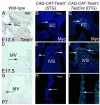
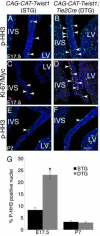
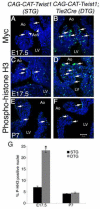


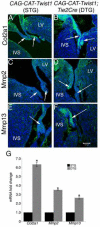
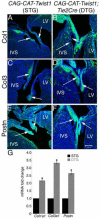

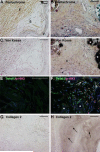
Similar articles
-
Twist1 directly regulates genes that promote cell proliferation and migration in developing heart valves.PLoS One. 2011;6(12):e29758. doi: 10.1371/journal.pone.0029758. Epub 2011 Dec 29. PLoS One. 2011. PMID: 22242143 Free PMC article.
-
Twist1 transcriptional targets in the developing atrio-ventricular canal of the mouse.PLoS One. 2012;7(7):e40815. doi: 10.1371/journal.pone.0040815. Epub 2012 Jul 16. PLoS One. 2012. PMID: 22815831 Free PMC article.
-
Twist1 function in endocardial cushion cell proliferation, migration, and differentiation during heart valve development.Dev Biol. 2008 May 1;317(1):282-95. doi: 10.1016/j.ydbio.2008.02.037. Epub 2008 Feb 29. Dev Biol. 2008. PMID: 18353304 Free PMC article.
-
Transcriptional regulation of heart valve progenitor cells.Pediatr Cardiol. 2010 Apr;31(3):414-21. doi: 10.1007/s00246-009-9616-x. Epub 2009 Dec 29. Pediatr Cardiol. 2010. PMID: 20039031 Free PMC article. Review.
-
Heart valve development: regulatory networks in development and disease.Circ Res. 2009 Aug 28;105(5):408-21. doi: 10.1161/CIRCRESAHA.109.201566. Circ Res. 2009. PMID: 19713546 Free PMC article. Review.
Cited by
-
Insufficient versican cleavage and Smad2 phosphorylation results in bicuspid aortic and pulmonary valves.J Mol Cell Cardiol. 2013 Jul;60:50-9. doi: 10.1016/j.yjmcc.2013.03.010. Epub 2013 Mar 24. J Mol Cell Cardiol. 2013. PMID: 23531444 Free PMC article.
-
Melt-electrowriting-enabled anisotropic scaffolds loaded with valve interstitial cells for heart valve tissue Engineering.J Nanobiotechnology. 2024 Jun 28;22(1):378. doi: 10.1186/s12951-024-02656-5. J Nanobiotechnology. 2024. PMID: 38943185 Free PMC article.
-
Human Organ-Specific Endothelial Cell Heterogeneity.iScience. 2018 Jun 29;4:20-35. doi: 10.1016/j.isci.2018.05.003. Epub 2018 May 9. iScience. 2018. PMID: 30240741 Free PMC article.
-
Differential Development of the Chordae Tendineae and Anterior Leaflet of the Bovine Mitral Valve.J Cardiovasc Dev Dis. 2024 Mar 29;11(4):106. doi: 10.3390/jcdd11040106. J Cardiovasc Dev Dis. 2024. PMID: 38667724 Free PMC article.
-
SOX9 in organogenesis: shared and unique transcriptional functions.Cell Mol Life Sci. 2022 Sep 17;79(10):522. doi: 10.1007/s00018-022-04543-4. Cell Mol Life Sci. 2022. PMID: 36114905 Free PMC article. Review.
References
-
- Aikawa E, Whittaker P, Farber M, Mendelson K, Padera RF, Aikawa M, Schoen FJ. Human semilunar cardiac valve remodeling by activated cells from fetus to adult. Circulation. 2006;113:1344–1352. - PubMed
Publication types
MeSH terms
Substances
Grants and funding
LinkOut - more resources
Full Text Sources
Medical
Molecular Biology Databases

